
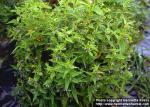 Preparations:
Extract of Scutellaria
- Fluid Extract of Scutellaria
Preparations:
Extract of Scutellaria
- Fluid Extract of Scutellaria
"The herb of Scutellaria lateriflora, Linné"—(U. S. P). The green herb is preferred in Eclectic pharmacy.
Nat. Ord.—Labiatae.
COMMON NAMES: Scullcap, Skullcap, Madweed.
ILLUSTRATION: Strong's American Flora (opposite page 100).
Botanical Source and History.—We introduce this plant, accompanied with illustrations, to overcome the confusion that has existed in commercial circles regarding the plant ordinarily sold as scullcap. The official species is the Scutellaria lateriflora, but the larger part of the drug sold upon the market under that name is derived from two other species of Scutellaria. The genus Scutellaria is well characterized by the calyx, which in all the species consists of 2 round lips closed in fruit, the upper lip of which has a helmet-shaped appendage, giving to it the appearance of a mask or cap; hence the common name scullcap.
Scutellaria lateriflora, Linné, the official scullcap, is the most widely-distributed of the species. It is common in every section of the United States, and is found growing in damp places on the banks of streams, and in similar situations. Inasmuch as this is the proper scullcap to use in medicine, and as it is often confounded with other species, we will give a close description of the plant (see Fig. 225). The stem is slender, herbaceous, 4-angled, much branched, and from 1 to 2 feet high; it is smooth, green when the plant grows in shady situations, but turns brown on exposure to the sun. The leaves are small, from 1 to 2 inches long, and about one-half as wide, ovate, rounded at the base, and acute at the apex. They are smooth, crenate, and are borne on opposite leaf-stalks, which are about 1 inch long. The flowers appear late in summer, and are borne in numerous, slender, simple, one-sided racemes, from the axils of the leaves; they are small, opposite, and have short pedicels, subtended at the base by small bracts. The calyx is about the length of the pedicel, and has the peculiar helmet-shape characteristic of the genus. When the fruit is mature, the calyx splits in the base, the upper lip falling away, the lower one remaining. The corolla is small, blue, about one-fourth of an inch long; it has a slender, exserted tube, and 2 subequal lips, the upper of which is arched, the lower, spreading. The stamens are 4, and included in the corolla. The fruit consists of 4 small nutlets.
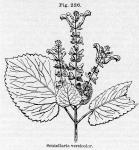 Scutellaria versicolor, Nuttall, and Scutellaria canescens, Nuttall, are the species generally collected by herbalists, and substituted for Scutellaria lateriflora. We present an engraving of Scutellaria versicolor, and both this and S. canescens can readily be distinguished from official scullcap, by their being much more robust, having thicker stems, and growing from 2 to 4 feet high. The flowers are large in both, being 1 inch long; and instead of being borne in very slender, lateral racemes, as with S. lateriflora, they are borne in a single, large, terminal, branched raceme. The leaves are also much larger than those of S. lateriflora, being from 2 to 4 inches long, and nearly as broad. They are cordate at the base, and acute at the apex. The leaves of S. versicolor are thin, softly pubescent, and of a bright-green color; those of S. canescens are thick in texture, light-green, and often variegated with a purple line around the margin.
Scutellaria versicolor, Nuttall, and Scutellaria canescens, Nuttall, are the species generally collected by herbalists, and substituted for Scutellaria lateriflora. We present an engraving of Scutellaria versicolor, and both this and S. canescens can readily be distinguished from official scullcap, by their being much more robust, having thicker stems, and growing from 2 to 4 feet high. The flowers are large in both, being 1 inch long; and instead of being borne in very slender, lateral racemes, as with S. lateriflora, they are borne in a single, large, terminal, branched raceme. The leaves are also much larger than those of S. lateriflora, being from 2 to 4 inches long, and nearly as broad. They are cordate at the base, and acute at the apex. The leaves of S. versicolor are thin, softly pubescent, and of a bright-green color; those of S. canescens are thick in texture, light-green, and often variegated with a purple line around the margin.
Scullcap is an indigenous herb, growing in damp places, meadows, ditches, and by the sides of ponds, flowering in July and August. Besides the names given above it is known by the names of Blue scullcap, Side-flowering scullcap, Mad-dog weed, and Hoodwort. The whole plant is official, though but the mature leaves and flowering tops should be employed. It should be gathered while in flower, dried in the shade, and kept in well-closed tin vessels. Alcohol or boiling water extracts its properties. It is officially described as" about 50 Cm. (20 inches) long, smooth; stem quadrangular, branched; leaves opposite, petiolate, about 5 Cm. (2 inches) long, ovate-lanceolate or ovate-oblong, serrate; flowers in axillary, one-sided racemes, with a pale-blue corolla and bilabiate calyx, closed in fruit, the upper lip helmet-shaped; odor slight; taste bitterish"—(U. S. P.). The drug loses its properties largely when dried, and by age becomes inert; hence the many failures in therapy from the use of scutellaria.
Chemical Composition.—Scutellaria lateriflora contains volatile and fixed oil, tannin, gum, sugar, and a bitter principle (Cadet de Gassicourt, 1824). C. O. Myers and H. R. Gillespie (Amer. Jour. Pharm., 1889, p. 555) obtained this bitter principle in the form of acicular crystals by treating an alcoholic extract of the drug with water and abstracting the principle from the aqueous solution with ether. The authors found it to be a glucosid; the presence of tannin in the drug could not be verified.
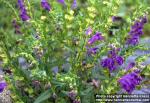 From the root of Scutellaria lanceolaria, Miquel (Scutellaria baicalensis, Georgi), growing in Japan, Takahashi (1889) isolated scutellarin (C10H8O3), crystallizing in yellow tasteless needles, sparingly soluble in hot water, soluble in other simple solvents and in alkalis. It is not a glucosid, and seems to be physiologically inert.
From the root of Scutellaria lanceolaria, Miquel (Scutellaria baicalensis, Georgi), growing in Japan, Takahashi (1889) isolated scutellarin (C10H8O3), crystallizing in yellow tasteless needles, sparingly soluble in hot water, soluble in other simple solvents and in alkalis. It is not a glucosid, and seems to be physiologically inert.
Action, Medical Uses, and Dosage.—Scullcap is tonic, nervine, and antispasmodic. This is one of those valuable agents which a certain class of physicians consider inert; yet it has proved especially useful in chorea, convulsions, tremors, intermittent fever, neuralgia, and many nervous affections. In delirium tremens, an infusion drank freely will soon produce a calm sleep. In intermittents it may be beneficially combined with lycopus. Where teething has impaired the health of children, an infusion maybe given with advantage. In all cases of nervous excitability, restlessness, or wakefulness, attending or following acute or chronic diseases, from physical or mental overwork, or from other causes, it may be drank freely with every expectation of beneficial results. The warm infusion has a tendency to keep the skin moist; the cold has a tonic influence, and either may be drank freely. When its soothing effects have ceased, it does not leave an excitable, irritable condition of the system, as is the case with some other nervines. Scullcap has been extolled as a remedy in hydrophobia, but this is still a matter of uncertainty. That it influences the cerebro-spinal centers, controlling nervous irritation there can be no doubt and this fact is well illustrated by its control over functional cardiac disorders, due to purely nervous causes, with or without hysterical manifestations, and exhibiting intermittency of pulse. Specific scutellaria well represents the plant. Half an ounce of the recently dried leaves or herb, to ½ pint of boiling water, will make a very strong infusion. Dose of specific scutellaria, 1 to 30 drops; of scutellarin, 1 to 5 grains; fluid extract, 1 to 60 drops.
Specific Indications and Uses.—Nervousness, attending or following acute or chronic diseases, or from mental or physical exhaustion, teething, etc.; nervousness manifesting itself in muscular action; tremors, subsultus, etc.; hysteria, with inability to control the voluntary muscles; functional cardiac disorders of a purely nervous type, with intermittent pulse.
Related Species.—Scutellaria pilosa, Linné, Scutellaria integrifolia, Linné, and Scutellaria hyssopifolia, Linné, now regarded as a variety of the last-named species, are sometimes employed. They are decidedly bitter. They possess properties similar to scullcap.
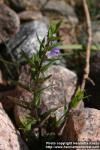 Scutellaria galericulata, Linné.—Europe, Asia, and North America; European scullcap. Odor, alliaceous; taste, bitter. Applied to old ulcerations, and given internally in intermittents.
Scutellaria galericulata, Linné.—Europe, Asia, and North America; European scullcap. Odor, alliaceous; taste, bitter. Applied to old ulcerations, and given internally in intermittents.
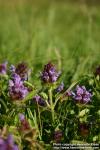 Brunella (or Prunella) vulgaris, Linné.—Self-heal, or Heal-all, is bitter and astringent. It is a common herb in the woods and grassy situations of Asia, Europe, and North America. The flowers are borne in dense bracted spikes and are of a purplish-blue color. It was once used locally in sore throat, and internally in diarrhoeal and hemorrhagic affections.
Brunella (or Prunella) vulgaris, Linné.—Self-heal, or Heal-all, is bitter and astringent. It is a common herb in the woods and grassy situations of Asia, Europe, and North America. The flowers are borne in dense bracted spikes and are of a purplish-blue color. It was once used locally in sore throat, and internally in diarrhoeal and hemorrhagic affections.
Derivative of Scutellaria.—SCUTELLARIN (Scutellarine). The preparation, erroneously called scutellarine, is one of the concentrations and is to be classed therewith. It is of a light greenish-brown color, with a faint, tea-like odor, and a peculiar, herbaceous, somewhat gritty, resinous, tea-like taste. It is reputed a nervine and tonic, especially useful in cases of depression of the nervous and vital powers after long sickness, over-exercise, excessive study, or from long-continued and exhausting labors. One grain will, it is stated, frequently produce its quiet and soothing effect, controlling nervous agitation, and inducing a sensation of calmness and strength. It has been advantageously combined with oleoresin of cypripedium, resin of cimicifuga, and resin of caulophyllum, in various female disorders, both in the gravid or nongravid state, accompanied with an excitable or irritable condition of the nervous system. It may be used wherever scullcap is indicated. Its dose is from 1 to 5 grains, 3 or 4 times a day, though an increased quantity will not produce any unpleasant effects (J. King).

